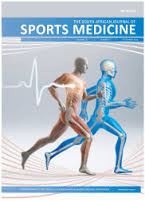Training and match load in professional rugby union: Do contextual factors influence the training week?
DOI:
https://doi.org/10.17159/2078-516X/2021/v33i1a9509Abstract
Background: Rugby union demands a multifaceted approach to training, given the multiple physical and technical attributes required to play the sport.
Objectives: The aim of this study is to describe the distribution of training throughout the week and investigate how this may be influenced by match-related factors. Methods: Training load data (session Rating of Perceived Exertion [sRPE], total distance and high-speed running [HSR]) were collected from six professional English rugby teams during the 2017/18 season. Five contextual factors were also recorded including: standard of opposition, competition type, result of previous fixture, surface type, and match venue.
Results: The day prior to matches demonstrated the lowest training load (101 AU (95% CIs: 0-216 AU) , 1 047 m (95% CIs:1 128-1 686 m) and 59 m (95% CIs: 0-343 m), respectively), while four days prior to the match demonstrated the highest training load (464 AU (95% CIs: 350-578), 2 983 m (95% CIs: 2 704-3 262m) and 234m (95% CIs: 0-477m), respectively). Of the five contextual factors, competition type was the only variable that demonstrated greater than trivial findings, with training before European fixtures the lowest stimulus across the four different competition types. Standard of opposition, previous result, surface type and venue had only trivial effects on training load (effect sizes = -0.13 to 0.15).
Conclusion: Future studies should outline the distribution of other training metrics, including contact and collision training. This study provides a multi-club evaluation that demonstrates the variety of loading strategies prior to competitive match play and highlights competition type as the most influential contextual factor impacting the average training load.
Downloads
Downloads
Published
Issue
Section
License
Copyright (c) 2021 South African Journal of Sports Medicine

This work is licensed under a Creative Commons Attribution 4.0 International License.
The South African Journal of Sports Medicine reserves copyright of the material published. The work is licensed under a Creative Commons Attribution 4.0 (CC BY 4.0) International License. Material submitted for publication in the South African Journal of Sports Medicine is accepted provided it has not been published elsewhere. The South African Journal of Sports Medicine does not hold itself responsible for statements made by the authors.
How to Cite
- Abstract 976
- PDF 600
- PDF (Supplementary) 71






.png)